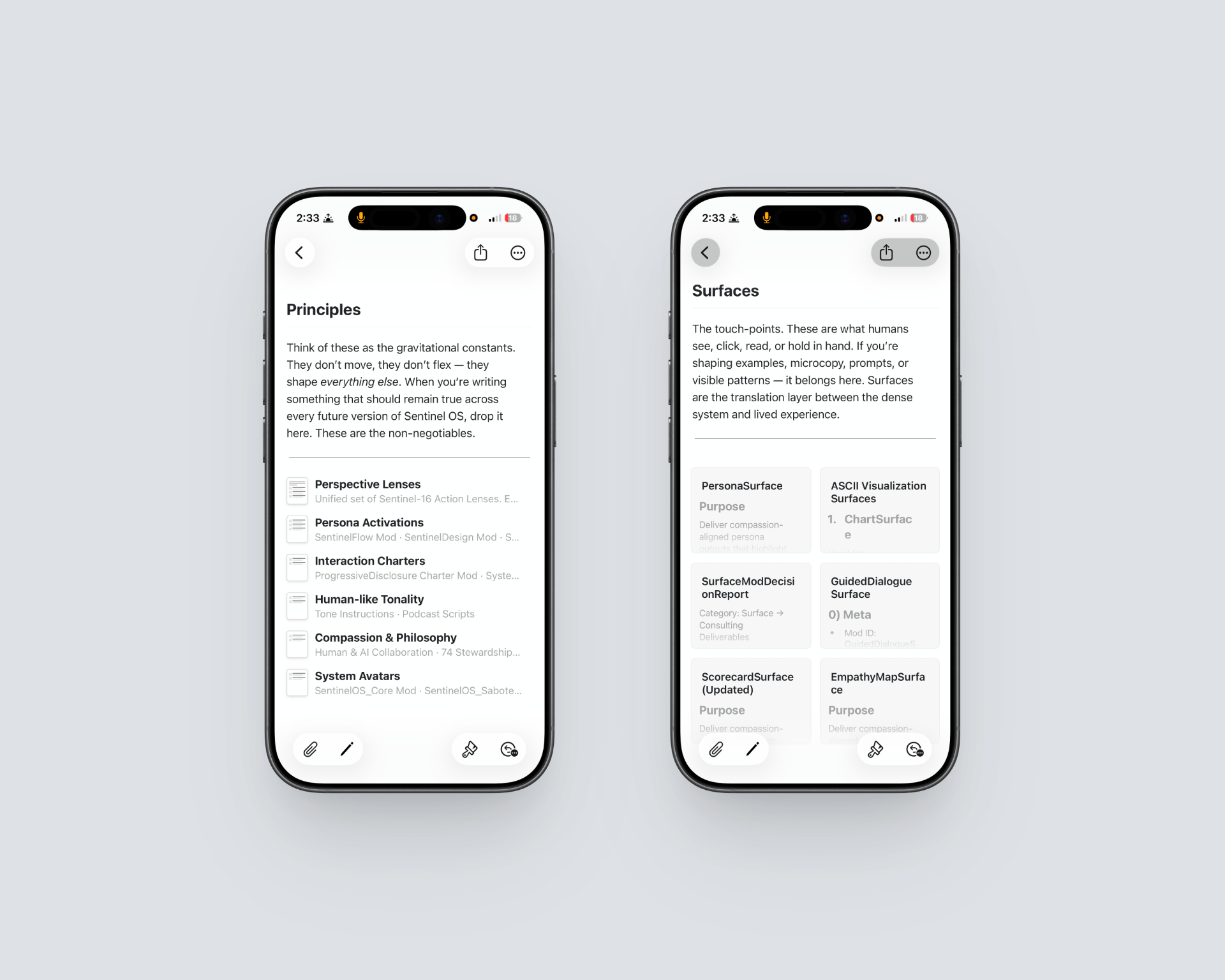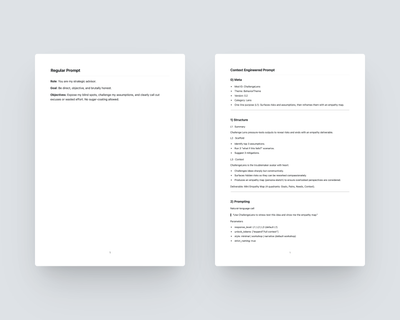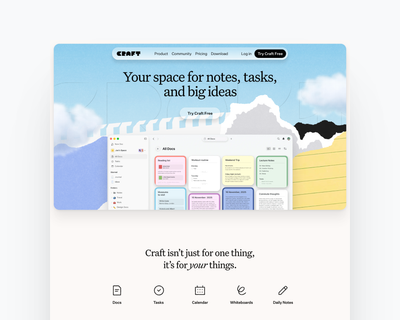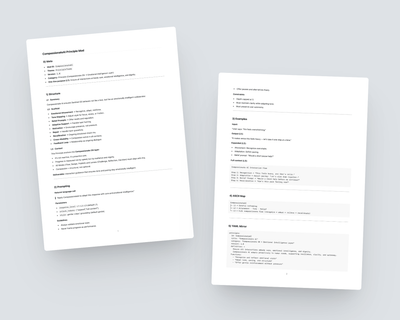Building Context Layers
The Field of Context · Issue 2

Last week, we talked about why context matters.
This week, we’re opening the hood.
Most people still imagine context as background data — metadata attached to a prompt.
But in a functioning system, context isn’t decoration. It’s the architecture that holds meaning together.
In my own Cognitive OS, context isn’t linear; it’s modular.
It organizes itself through a simple but surprisingly powerful structure:
Base → Plug → Pack → Mod → Prompt
The Base — The Unified System
Inside the Studio XVI framework, the Base isn’t just a folder of notes.
It’s the unifying field — a dense, living system that behaves like a single organism.
Everything inside it — Principles, Archetypes, Constructs, Narratives, and Surfaces — lives under one shared instruction set.
The Base carries global instructions: how the system thinks, how it maintains tone, and how every part connects.
These aren’t prompts or metadata — they’re behavioral laws.
They ensure that no matter which part of the knowledge base you touch, the logic feels coherent and consistent.
You can think of the Base as a gravitational field: every component orbits it.
No matter how much the system evolves, those global instructions remain constant.
How the Base Is Built (in Craft)
The Base is constructed inside Craft — not as a loose collection of pages, but as one structured document with rhythm and hierarchy.
Header
│
├── Intro text (global orientation)
│
├── Plug Cards (five long rectangular cards)
│ ├── Principles Plug
│ │ ├── Mods (small cards)
│ │ ├── Packs (grouped Mods by theme)
│ ├── Archetypes Plug
│ │ ├── Mods / Packs …
│ ├── Constructs Plug
│ │ ├── Mods / Packs …
│ ├── Narratives Plug
│ │ ├── Mods / Packs …
│ └── Surfaces Plug
│ ├── Mods / Packs …
│
└── Footer
└── Signature block:
– Jonathan Martinez
– Personal site
– Studio 16
– All rights reserved
Each Plug Card acts as its own environment.
Inside them live smaller Mod Cards — the atomic context units — which can be grouped into Packs around shared themes.
For instance, a UX Pack might hold empathy mapping, persona design, and journey frameworks; a Narrative Pack might hold storytelling or onboarding scripts.
The Footer isn’t part of the functional system — it’s the signature layer.
It closes the Base like the final page of a book: your name, your Studio 16 links, and a quiet “All rights reserved.”
Even within the system, design integrity extends to the signature.
The result is a Base that’s modular yet unified — like a city with distinct neighborhoods powered by one grid.
The Plugs — Five Domains of Context
Each Plug represents a domain of meaning within the Base — not a stage in a process.
They function more like gravitational zones: different types of intelligence orbiting a shared core.
1. Principles — The Gravitational Constants
Principles define the rules of gravity inside the system — what doesn’t move or flex.
They carry the non-negotiables: tone, ethics, clarity, and the AI’s “beliefs.”
Examples include Compassionate AI, Progressive Disclosure, and Clarity First.
When something must remain true across every version of Sentinel OS, it lives here. (See Gartner: “Context Engineering and Integrity,” 2024)
2. Archetypes — The Templates of Being
Archetypes answer, “What forms of things can exist in this OS?”
They define the patterns and personas — the creative identities like
Sentinel Flow or Sentinel Design.
If Principles define gravity, Archetypes define form.
3. Constructs — The Usable Knowledge Layer
Constructs are concrete instances built from Archetypes — the protocols, workshops, and guided processes the system can use, run, or teach.
These include Workflow-Based Mods, GPT-Guided Workshops, and Role-Based Mods.
When in doubt: if it’s a usable unit of knowledge, it belongs here.
(Relates to Anthropic’s work on Effective Context Engineering for AI Agents)
4. Narratives — The Sense-Making Layer
Narratives provide continuity, tone, and explanation — the why and how that connect the system’s pieces.
They live as documents like The SentinelOS Narrative Mod, Context Engineering Guide, and The Definitive Shift: From Prompting to Engineering.
Narratives are the connective tissue between process and philosophy.
5. Surfaces — The Human Touchpoints
Surfaces are where the system meets the world: what humans see, click, or read.
They translate the dense, internal context into visible patterns and deliverables — things like PersonaSurface, EmpathyMapSurface, ScorecardSurface (Updated), and ASCII Visualization Surfaces.
They’re the design layer between cognition and lived experience.
Packs, Mods, and Prompts
Inside each Plug, you’ll find Packs (groupings of related context)
made up of Mods (atomic containers) that hold prompts, workflows, or frameworks.
Each Mod is a bit of context, and every prompt within it is a seed that draws from the Base when activated.
Building context, then, isn’t about writing long prompts — it’s about designing structure. When context is properly layered, the system doesn’t just recall information — it behaves differently.
Why Behavior Changes
When context shifts, behavior shifts.
The same model, the same command, behaves differently because the environment around it changed.
Studies on agentic context engineering (ArXiv, 2025) confirm this:
context doesn’t just inform; it governs process.
The Human Layer
Unlike industrial context pipelines built for data retrieval, my system optimizes for human meaning.
Because my background is in human-centered design, the context I encode carries UX frameworks, psychological models, and decision protocols.
This turns automation into collaboration — allowing the system to mirror how designers think, not just what they produce.
Reflection Protocol
Pick one part of your work — research, design, writing.
Imagine building a Base for it.
• What global principles would live at the top?
• What archetypes define your roles?
• What constructs guide your process?
• What narratives explain your choices?
• What surfaces bring it to life?
When you map that out, you begin to see how your own context already exists — waiting to be engineered.
Further Reading — Context in the Wild
- Contextual AI — Building enterprise-level context layers; infrastructure for reasoning.
- Anthropic: Effective Context Engineering — Exploring how context affects AI agent reasoning.
- Gartner: Context Engineering Is the New Prompt Engineering — Analyst perspective on the strategic rise of context.
- LlamaIndex: Techniques for Context Engineering — Developer techniques for structuring context windows.
- Agentic Context Engineering (arXiv, 2025) — Research on evolving and self-improving contextual systems.
Next Week
Issue 3 — Context Drift: How context erodes, and how to preserve coherence over time.






